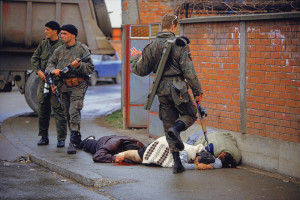 During the Balkans conflict of 1992-1995, the Bosnian town of Srebrenica was declared a UN Safe Area in 1993, under the watch of the United Nations Protection Force (UNPROFOR).
During the Balkans conflict of 1992-1995, the Bosnian town of Srebrenica was declared a UN Safe Area in 1993, under the watch of the United Nations Protection Force (UNPROFOR).
In July 1995, General Ratko Mladić and his Serbian paramilitary units overran and captured the town, despite its designation as an area “free from any armed attack or any other hostile act”.
In the days following Srebrenica’s fall, more than 8,000 Bosnian Muslim men and boys were systematically massacred and buried in mass graves. Thousands of women, children and elderly people were forcibly deported and a large number of women were raped. It was the greatest atrocity on European soil since the Second World War.
The International Court of Justice (ICJ) and the International Criminal Tribunal for the Former Yugoslavia (ICTY) ruled that the mass execution of Bosniak men and boys in Srebrenica constituted genocide.
Judge Fouad Riad, who reviewed the indictment, described the “unimaginable savagery” that the victims endured at the hands of Mladic’s forces. He said these were: “truly scenes from hell, written on the darkest pages of human history.”
In 1999, UN Secretary-General Kofi Annan wrote:
“Through error, misjudgment and an inability to recognize the scope of the evil confronting us, we failed to do our part to help save the people of Srebrenica from the Serb campaign of mass murder.”
For more on Srebrenica, please visit: http://srebrenica.org.uk/

